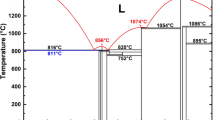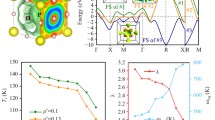Abstract
In general, conventional superconductivity and magnetism are competing phenomena. In some alloys this competition is a function of the concentration of the elements. Here we show that in the palladium alloys Pd\(_{1-c}\)(H/D/T)\(_{c}\) (Pd-ides) the increase in the concentration c of the ides: hydrogen, deuterium, tritium (H/D/T), lowers the predicted magnetism of amorphous palladium (a-Pd) gradually, allowing superconductivity to appear for \( c \approx 40\%\). This magnetism explains why superconductivity does not manifest for smaller values of c (\(c \le 40\%\)) in these Pd alloys. These results validate indirectly our predicted magnetism in the amorphous/porous palladium (a/p-Pd) providing a different strategy to explore the phase diagram of competing magnetic and superconducting phases.





Similar content being viewed by others
Availability of Data and Materials
The datasets generated during and/or analysed during the current study are available from the corresponding author on reasonable request
Code Availability
Materials Studio is a licensed software acquired from Dassault Systèmes BIOVIA.
References
I. Rodríguez, R.M. Valladares, D. Hinojosa-Romero, A. Valladares, A.A. Valladares, Emergence of magnetism in bulk amorphous palladium. Phys. Rev. B 100(2), 024422 (2019). https://doi.org/10.1103/PhysRevB.100.024422
T. Skoskiewicz, Superconductivity in the palladium-hydrogen and palladium-nickel-hydrogen systems. Phys. Status Solidi (A) 11(2), 123–126 (1972). https://doi.org/10.1002/pssa.2210110253
R. Kleiner, W. Buckel, Superconductivity: An Introduction, 3 updated. (Wiley-VCH Verlag GmbH & Co. KGaA, Weinheim, 2016)
B. Stritzker, W. Buckel, Superconductivity in the palladium-hydrogen and the palladium-deuterium systems. Z. Phys, 257(1), 1–8 (1972). https://doi.org/10.1007/BF01398191
J. Bardeen, L.N. Cooper, J.R. Schrieffer, Theory of superconductivity. Phys. Rev. 108(5), 1175–1204 (1957). https://doi.org/10.1103/PhysRev.108.1175
J.E. Schirber, C.J.M. Northrup, Concentration dependence of the superconducting transition temperature in PdH\(_x\) and PdD\(_x\). Phys. Rev. B 10(9), 3818–3820 (1974). https://doi.org/10.1103/PhysRevB.10.3818
J.E. Schirber, J.M. Mintz, W. Wall, Superconductivity of palladium tritide. Solid State Commun. 52(10), 837–838 (1984). https://doi.org/10.1016/0038-1098(84)90251-5
D.A. Papaconstantopoulos, B.M. Klein, E.N. Economou, L.L. Boyer, Band structure and superconductivity of PdD\(_x\) and PdH\(_x\). Phys. Rev. B 17(1), 141–150 (1978). https://doi.org/10.1103/PhysRevB.17.141
D. Fay, J. Appel, Possibility of triplet pairing in palladium. Phys. Rev. B 16(5), 2325–2328 (1977). https://doi.org/10.1103/PhysRevB.16.2325
K.H. Bennemann, J.W. Garland, Theory for superconductivity in Pd-H and Pd-D systems. Z. Phys. 260(5), 367–374 (1973). https://doi.org/10.1007/BF01397961
D.A. Papaconstantopoulos, B.M. Klein, Superconductivity in the Palladium-Hydrogen System. Phys. Rev. Lett. 35(2), 110–113 (1975). https://doi.org/10.1103/PhysRevLett.35.110
F.J. Pinski, P.B. Allen, W.H. Butler, Electron-phonon contribution to electrical resistivity and superconducting “p -Wave’’ transition temperature of Pd. Phys. Rev. Lett. 41(6), 431–434 (1978). https://doi.org/10.1103/PhysRevLett.41.431
G. Gladstone, M.A. Jensen, J.R. Schrieffer, Electron–electron interactions in the normal state, in Superconductivity, vol. 2, ed. by R.D. Parks (Dekker, New York, 1969), pp.682–706
V.L. Moruzzi, P.M. Marcus, Magnetism in fcc rhodium and palladium. Phys. Rev. B 39(1), 471–474 (1989). https://doi.org/10.1103/PhysRevB.39.471
B. Sampedro, P. Crespo, A. Hernando, R. Litrán, J.C. Sánchez López, C. López Cartes, A. Fernandez, J. Ramírez, J. González Calbet, M. Vallet, Ferromagnetism in fcc twinned 2.4 nm size Pd nanoparticles. Phys. Rev. Lett. 91(23), 237203 (2003). https://doi.org/10.1103/PhysRevLett.91.237203
D. Mendoza, F. Morales, R. Escudero, J. Walter, Magnetization studies in quasi two-dimensional palladium nanoparticles encapsulated in a graphite host. Phys. Condens. Matter 11(28), 317–322 (1999). https://doi.org/10.1088/0953-8984/11/28/101
A.A. Valladares, A new approach to the ab initio generation of amorphous semiconducting structures. Electronic and vibrational studies, in Glass Materials Research Progress. ed. by J.C. Wolf, L. Lange (Nova Science Publishers, New York, 2008), pp. 61–123. OCLC: 213375899
C. Romero, J. Noyola, U. Santiago, R. Valladares, A. Valladares, A. Valladares, A new approach to the computer modeling of amorphous nanoporous structures of semiconducting and metallic materials: a review. Materials 3(1), 467–502 (2010). https://doi.org/10.3390/ma3010467
A.A. Valladares, J.A. Díaz-Celaya, J. Galván-Colín, L.M. Mejía-Mendoza, J.A. Reyes-Retana, R.M. Valladares, A. Valladares, F. Alvarez-Ramirez, D. Qu, J. Shen, New approaches to the computer simulation of amorphous alloys: a review. Materials 4(4), 716–781 (2011). https://doi.org/10.3390/ma4040716
T. Masumoto, T. Fukunaga, K. Suzuki, Abstract of topical conf. on the atomic scale structure of amophous solids. Bull. Am. Phys. Soc. 23, 467 (1978)
Y. Waseda, The Structure of Non-crystalline Materials: Liquids and Amorphous Solids (McGraw-Hill International Book Co., New York, 1980)
X. Yang, H. Li, R. Ahuja, T. Kang, W. Luo, Formation and electronic properties of palladium hydrides and palladium–rhodium dihydride alloys under pressure. Sci. Rep. 7(1), 3520 (2017). https://doi.org/10.1038/s41598-017-02617-z
A.J. Dekker, Solid State Physics (Macmillan, London, 1957)
B. Stritzker, Superconductivity of disordered palladium. J. Phys. Lett. 39(21), 397–398 (1978). https://doi.org/10.1051/jphyslet:019780039021039700
B. Stritzker, Superconductivity in irradiated palladium. Phys. Rev. Lett. 42(26), 1769–1773 (1979). https://doi.org/10.1103/PhysRevLett.42.1769
F.D. Manchester, A. San-Martin, J.M. Pitre, The H–Pd (hydrogen–palladium) system. JPE 15(1), 62–83 (1994). https://doi.org/10.1007/bf02667685
S.J. Clark, M.D. Segall, C.J. Pickard, P.J. Hasnip, M.I.J. Probert, K. Refson, M.C. Payne, First principles methods using CASTEP. Zeitschrift für Kristallographie Cryst. Mater. 220(5/6), 567–570 (2005). https://doi.org/10.1524/zkri.220.5.567.65075
Dassault Systèmes BIOVIA, Materials Studio 2016: Forcite. CASTEP (Dassault Systèmes BIOVIA, 2016)
R.D. Johnson, Computational Chemistry Comparison and Benchmark Database, NIST Standard Reference Database 101 (National Institute of Standards and Technology, 2002). https://doi.org/10.18434/T47C7Z
Z. Mata-Pinzón, A.A. Valladares, R.M. Valladares, A. Valladares, Superconductivity in bismuth. A new look at an old problem. PLoS ONE 11(1), 0147645 (2016). https://doi.org/10.1371/journal.pone.0147645
Acknowledgements
I.R. thanks DGAPA-UNAM for the postdoctoral fellowship. D.H.R. acknowledges Consejo Nacional de Ciencia y Tecnología (CONACyT) for supporting his graduate studies. A.A.V., R.M.V., and A.V. thank DGAPA-UNAM for continued financial support to carry out research project under Grant No. IN116520. M.T. Vázquez and O. Jiménez provided the information requested. A. López and A. Pompa provided technical support and maintenance of the computing unit at IIM-UNAM. Simulations were partially carried out in the Computing Center of DGTIC-UNAM.
Funding
Financial support was recieved from DGAPA-UNAM under Grant No. IN116520.
Author information
Authors and Affiliations
Contributions
AAV, AV and RMV conceived this research and designed it with the participation of IR and DHR IR did all the simulations. All authors discussed and analyzed the results. AAV wrote the first draft and the other authors enriched the manuscript.
Corresponding author
Ethics declarations
Conflict of interest
The authors declare no competing interests.
Consent to Participate
Not applicable.
Consent for Publication
The authors gave their consent for the publication of this manuscript.
Ethics Approval
Not applicable.
Additional information
Publisher's Note
Springer Nature remains neutral with regard to jurisdictional claims in published maps and institutional affiliations.
Rights and permissions
Springer Nature or its licensor holds exclusive rights to this article under a publishing agreement with the author(s) or other rightsholder(s); author self-archiving of the accepted manuscript version of this article is solely governed by the terms of such publishing agreement and applicable law.
About this article
Cite this article
Rodríguez, I., Valladares, R.M., Valladares, A. et al. Superconductivity Versus Magnetism in the Amorphous Palladium “Ides”: Pd1−c(H/D/T)c. J Low Temp Phys 209, 232–243 (2022). https://doi.org/10.1007/s10909-022-02807-8
Received:
Accepted:
Published:
Issue Date:
DOI: https://doi.org/10.1007/s10909-022-02807-8




